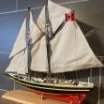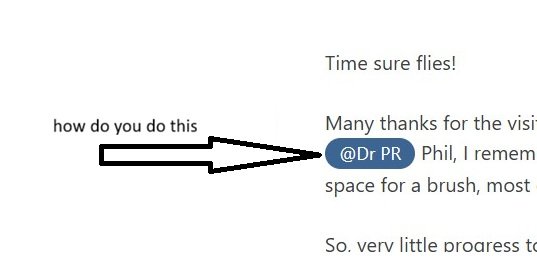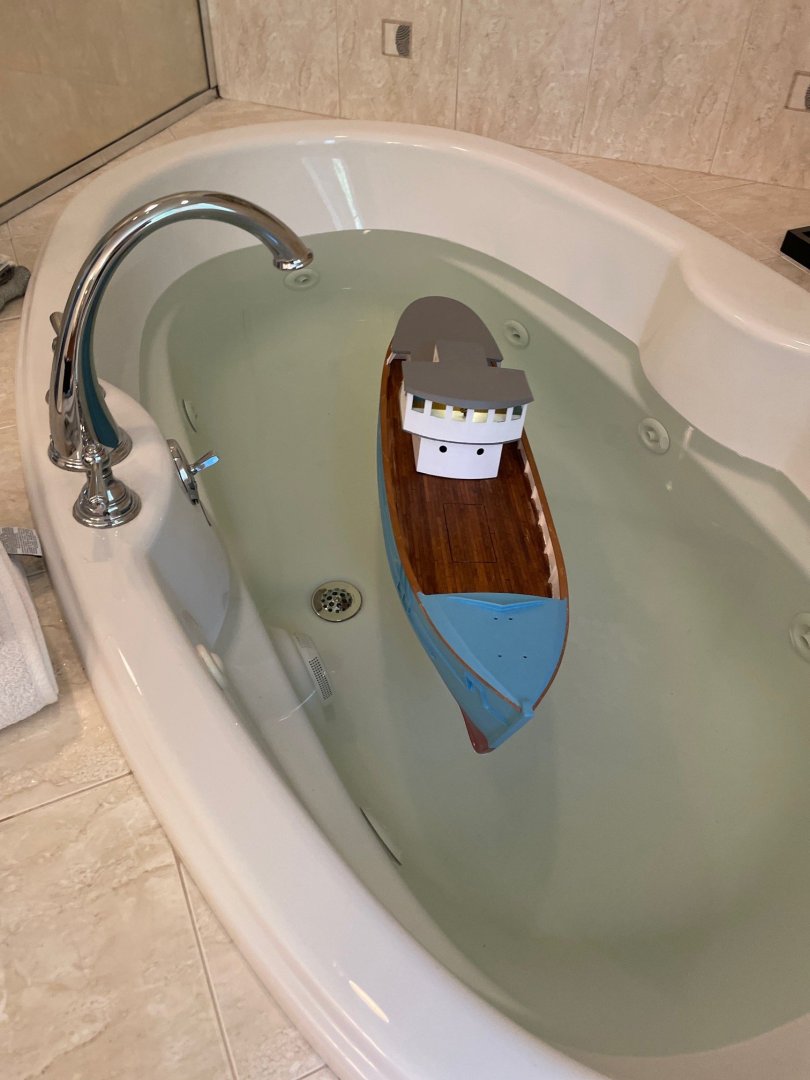-
Posts
835 -
Joined
-
Last visited
About _SalD_

Profile Information
-
Gender
Not Telling
-
Location
Sarasota, FL
Recent Profile Visitors
-
 Canute reacted to a post in a topic:
USCG Harriet Lane by Knocklouder - Model Shipways - 1:144 (1/12 inch = 1 foot)
Canute reacted to a post in a topic:
USCG Harriet Lane by Knocklouder - Model Shipways - 1:144 (1/12 inch = 1 foot)
-
 _SalD_ reacted to a post in a topic:
Starcraft Adjutant AI by yvesvidal - 1/6 - RESIN/PLASTIC
_SalD_ reacted to a post in a topic:
Starcraft Adjutant AI by yvesvidal - 1/6 - RESIN/PLASTIC
-
 palmerit reacted to a post in a topic:
How to add name tag to post
palmerit reacted to a post in a topic:
How to add name tag to post
-
 _SalD_ reacted to a post in a topic:
How to add name tag to post
_SalD_ reacted to a post in a topic:
How to add name tag to post
-
Please forgive me if this is covered somewhere in this forum. I’ve looked through a number of posts but couldn’t find anything that answers this. I’m sure this is obvious to those who are more text-savvy, but could someone tell me how to create those blue shaded name tags? (See picture below.) Thank you.
-
 _SalD_ reacted to a post in a topic:
Arado Ar-196 by Ian B - PLASTIC - German seaplane
_SalD_ reacted to a post in a topic:
Arado Ar-196 by Ian B - PLASTIC - German seaplane
-
 _SalD_ reacted to a post in a topic:
Arado Ar-196 by Ian B - PLASTIC - German seaplane
_SalD_ reacted to a post in a topic:
Arado Ar-196 by Ian B - PLASTIC - German seaplane
-
 rcweir reacted to a post in a topic:
NORDKAP 476 by _SalD_ - Billing Boats - 1:50 - RADIO
rcweir reacted to a post in a topic:
NORDKAP 476 by _SalD_ - Billing Boats - 1:50 - RADIO
-
 rcweir reacted to a post in a topic:
NORDKAP 476 by _SalD_ - Billing Boats - 1:50 - RADIO
rcweir reacted to a post in a topic:
NORDKAP 476 by _SalD_ - Billing Boats - 1:50 - RADIO
-
 rcweir reacted to a post in a topic:
NORDKAP 476 by _SalD_ - Billing Boats - 1:50 - RADIO
rcweir reacted to a post in a topic:
NORDKAP 476 by _SalD_ - Billing Boats - 1:50 - RADIO
-
 Ian_Grant reacted to a post in a topic:
NORDKAP 476 by _SalD_ - Billing Boats - 1:50 - RADIO
Ian_Grant reacted to a post in a topic:
NORDKAP 476 by _SalD_ - Billing Boats - 1:50 - RADIO
-
 _SalD_ reacted to a post in a topic:
NORDKAP 476 by _SalD_ - Billing Boats - 1:50 - RADIO
_SalD_ reacted to a post in a topic:
NORDKAP 476 by _SalD_ - Billing Boats - 1:50 - RADIO
-
Maybe I’ll just keep her on the shelf and watch the propeller go around 😄😉. Kidding, of course. Damn the torpedoes—full speed ahead.
- 56 replies
-
- Nordkap
- Billing Boats
-
(and 1 more)
Tagged with:
-
 _SalD_ reacted to a post in a topic:
USCG Harriet Lane by Knocklouder - Model Shipways - 1:144 (1/12 inch = 1 foot)
_SalD_ reacted to a post in a topic:
USCG Harriet Lane by Knocklouder - Model Shipways - 1:144 (1/12 inch = 1 foot)
-
 robert952 reacted to a post in a topic:
USCG Harriet Lane by Knocklouder - Model Shipways - 1:144 (1/12 inch = 1 foot)
robert952 reacted to a post in a topic:
USCG Harriet Lane by Knocklouder - Model Shipways - 1:144 (1/12 inch = 1 foot)
-
 king derelict reacted to a post in a topic:
NORDKAP 476 by _SalD_ - Billing Boats - 1:50 - RADIO
king derelict reacted to a post in a topic:
NORDKAP 476 by _SalD_ - Billing Boats - 1:50 - RADIO
-
Hi Craig, Thank you for your input. I believe I performed that calibration when I first installed all the electronics. The propeller RPM does vary with throttle position, so I think it’s working correctly. In the tub, since I’m not yet used to the controls, I pushed the throttle a little too far forward and didn’t have much room to work with. I think once I get it into a larger body of water, I’ll be able to get used to them more easily.
- 56 replies
-
- Nordkap
- Billing Boats
-
(and 1 more)
Tagged with:
-
 Ian_Grant reacted to a post in a topic:
NORDKAP 476 by _SalD_ - Billing Boats - 1:50 - RADIO
Ian_Grant reacted to a post in a topic:
NORDKAP 476 by _SalD_ - Billing Boats - 1:50 - RADIO
-
 Keith Black reacted to a post in a topic:
USCG Harriet Lane by Knocklouder - Model Shipways - 1:144 (1/12 inch = 1 foot)
Keith Black reacted to a post in a topic:
USCG Harriet Lane by Knocklouder - Model Shipways - 1:144 (1/12 inch = 1 foot)
-
Ship is looking great Knocklouder. I like the name decals and was wondering how you made them.
- 51 replies
-
- Steam Cutter
- Harriet Lane
-
(and 1 more)
Tagged with:
-
Thanks, Alan. I forgot to mention in my post that I didn’t use the white rigging thread provided with the kit. Instead, I substituted some rigging I had left over from a previous model—black for the standing rigging and tan for the running rigging. Thanks for the kind words, Ian. There is an edge plank (coaming) around the perimeter of the opening where the cabin is located. It’s not very high (about 1/8"). I could probably add an extension to make it a little higher if you think it should be. You made me think however about the battery hatch I cut into the main deck. I'll need to come up with something to waterproof it. LOL—of course I had to try it out in the tub, and to my surprise the boat is a little faster than I anticipated. Good thing the tub has rounded edges, no damage to boat or tub. I did get it to move forward and reverse, and still no leaks.
- 56 replies
-
- Nordkap
- Billing Boats
-
(and 1 more)
Tagged with:
-
Stepping the Mast: The mast and boom were pre-assembled with all their attachments and painted before being installed on the ship. My standard method for stepping the mast involves using a 45-degree right triangle. I use the triangle to help ensure the mast is plumb athwartships. First, I scribe a line in the plastic triangle, bisecting the 90-degree angle and making it perpendicular to the hypotenuse. Then, I measure the overall distance athwartships from the outboard edges of each cap rail, where the triangle will be placed. Dividing this distance in half, I mark the same measurement on either side of the scribed line along the hypotenuse of the triangle. Next, I position the triangle upright against the mast, ensuring that the two marks line up with the edges of the cap rail. With the apex of the bisected 90-degree angle centered on the ship, it will be perfectly perpendicular to the deck. The position of the mast fore and aft sometimes needs to be braced into position, this mast I did not have to do that. I use white glue for this step, as it allows me time to adjust the mast into its final position. The main advantage of this method is that it doesn't require the ship to be perfectly leveled. As long as the ship has a reasonable degree of symmetry, and the triangle is correctly positioned across the cap rails, the apex of the triangle will always be centered on the ship and 90 degrees to the deck. While I’m not certain whether these types of masts would traditionally have a mast coat, I did apply one to provide additional support for the mast. Mast and Boom Installation: With the mast and boom in place, I moved on to rigging the block and tackles. This part was fairly straightforward, though I did make one mistake: I should have waited to glue the fish storage bin in place until after completing the rigging. First, the wire bracing for both the mast and the forward deck crane were then installed. Next, the rigging for the boom Then the mast rigging Additionally, I added the wire bracing for the aft deck crane. Since this bracing runs from the crane to the superstructure (which must be removed in order to install the battery and turn the motor on), I didn’t glue this bracing in place. This will allow me to remove it easily when needed. Getting close to the end now, just a few more odds and ends to complete. Then I think another water test is called for. Thanks for looking and for the likes.
- 56 replies
-
- Nordkap
- Billing Boats
-
(and 1 more)
Tagged with:
-
I was a little slow posting this update because I’m just getting over my first case of COVID. It took five years to finally catch it, and when I did, it did a pretty good job on me—but I’m all better now. I started at the bow, installing the handrail and windlass. To accurately locate the handrail posts, I made a photocopy of the bow section from the plans and taped it in place as a guide. I used a compass point to mark all the locations. I also marked the bollard locations on the deck. Next, I installed the ladder, deck hatches, and the larger windlass on the main deck. The two higher hatches are mounted on the removable deck portion to access the battery. After that, I jumped over to the hull pin striping. I had some 1/16” white pinstripe tape left over from another project, and it worked out very nicely. Then it was back to the superstructure. I installed the rear antenna support and the cable handrail, finished painting the stack and the anchors, and added pins to the anchors to help secure them to the hull. Thanks for looking in and for the likes.
- 56 replies
-
- Nordkap
- Billing Boats
-
(and 1 more)
Tagged with:
-
Going to grab some popcorn, sit back and follow along. Good luck on the build Bob.
- 51 replies
-
- Steam Cutter
- Harriet Lane
-
(and 1 more)
Tagged with:
-
Thanks Alan, I appreciate the nice comments and thanks for looking at my build.
- 56 replies
-
- Nordkap
- Billing Boats
-
(and 1 more)
Tagged with:
-
Continuing with the miscellaneous deck items: Assembled and painted the windlasses Smokestack Deck hatches Two deck cranes Next, I began populating the superstructure with the assembled components: Superstructure upper deck Superstructure lower deck For the ladder rungs located on the sides, I drew up a template so I could accurately locate the holes for each rung. I also installed the handrails and lighting fixtures. Just a note: I had to order more 1 mm diameter brass rods for the handrailings because the kit didn’t include enough. Ordered it from Amazon.
- 56 replies
-
- Nordkap
- Billing Boats
-
(and 1 more)
Tagged with:
-
Thanks to a new member of MSW, buntzi, I was informed through an email that the items pictured below are trawl doors. Their function is to keep the mouth of the net open as it is dragged along the bottom. Thank you, buntzi.
- 56 replies
-
- Nordkap
- Billing Boats
-
(and 1 more)
Tagged with:
-

Help Needed: Motorizing the Nordkap model for RC Use
_SalD_ replied to _SalD_'s topic in RC Kits & Scratch building
buntzi, thanks for the info. I don't check this post to often that's why it took me a while to get back to you. -
I decided to change things up a bit and start working on the miscellaneous deck items. Once I figured out which pieces to use, assembly was pretty straightforward. Deck Crane That came together nicely. Antenna (I think?) I’m assuming this is some kind of antenna. I added a small post to the bottom of the brass top to attach it more securely to the wooden dowel. Radar Tower That went together smoothly as well. Painting Details I also painted the door and window frames. Then I came to this piece. I put it together, but for the life of me I can’t figure out what it is or what it’s supposed to be used for. I’ve checked other builds and searched various trawler websites, but I haven’t been able to identify it. Anyone have any ideas? Thanks again for the likes.
- 56 replies
-
- Nordkap
- Billing Boats
-
(and 1 more)
Tagged with:
-
Float Test With all the electronics installed, I thought it would be a good time to give the ship another float test. As you can see, there’s a slight list to the port side, and the bow sits a bit high. To correct this, I plan to use lead shot salvaged from an old diving weight belt as adjustable ballast. After draining the tub, I realized that the list may have been influenced by the battery placement, as it’s relatively heavy and it might have been positioned off-center. I’ll verify this next time by temporarily relocating the battery to confirm whether it’s the primary cause of the imbalance. Oh, and still no leaks.
- 56 replies
-
- Nordkap
- Billing Boats
-
(and 1 more)
Tagged with:
About us
Modelshipworld - Advancing Ship Modeling through Research
SSL Secured
Your security is important for us so this Website is SSL-Secured
NRG Mailing Address
Nautical Research Guild
237 South Lincoln Street
Westmont IL, 60559-1917
Model Ship World ® and the MSW logo are Registered Trademarks, and belong to the Nautical Research Guild (United States Patent and Trademark Office: No. 6,929,264 & No. 6,929,274, registered Dec. 20, 2022)
Helpful Links
About the NRG
If you enjoy building ship models that are historically accurate as well as beautiful, then The Nautical Research Guild (NRG) is just right for you.
The Guild is a non-profit educational organization whose mission is to “Advance Ship Modeling Through Research”. We provide support to our members in their efforts to raise the quality of their model ships.
The Nautical Research Guild has published our world-renowned quarterly magazine, The Nautical Research Journal, since 1955. The pages of the Journal are full of articles by accomplished ship modelers who show you how they create those exquisite details on their models, and by maritime historians who show you the correct details to build. The Journal is available in both print and digital editions. Go to the NRG web site (www.thenrg.org) to download a complimentary digital copy of the Journal. The NRG also publishes plan sets, books and compilations of back issues of the Journal and the former Ships in Scale and Model Ship Builder magazines.











